Martienssen W., Warlimont H. (Eds.). Handbook of Condensed Matter and Materials Data
Подождите немного. Документ загружается.


712 Part 4 Functional Materials
An extensive compilation of the oxide superconduc-
tors of the class called low-T
c
superconductors is given
in [2.11]. Some data, which are relevant to bulk mater-
ials revealing relatively high T
c
values are summarized
in Table 4.2-11.
For metallic superconductors the electron–phonon
interaction accounts for the superconductivity of low-T
c
oxide conductors. For all of these materials the electri-
cal parameters indicated in Table 4.2-11 depend on the
electron mean free path, and thus on the resistivity ρ,of
the material in the normal state. The quantitative relation
for H
c2
is given by
µ
0
H
c2
(0) = 3.11 ργ T
c
,
where γ is the electronic specific heat. As a consequence
of the influence of ρ on T
c
and H
c
, both parame-
ters depend not only on the stoichiometric composition
of the multi-component oxides but also on impuri-
ties and lattice defects introduced by the preparation.
Accordingly, in the literature the electrical parame-
ters are not all identical to those of Table 4.2-11. For
BaPb
1−x
Bi
x
O
3
compounds the following values of co-
herence length ξ
0
and London penetration depth λ were
published: ξ
0
= 2400, 250, 50 nm, λ = 0.5, 0.7, 1.5nm
for x = 0, 0.12 and 0.3, respectively [2.11].
High-T
c
Superconducting Oxides
Chemical Composition. Bednorz and Müller carried
out a series of investigations aiming to enhance the
electron–phonon interaction in superconducting oxides.
As a result, they found superconductivity at around 30 K
in the Ba
−
La
−
Cu
−
O system [2.12]. These compounds
Table 4.2-12 General chemical formulas of high-T
c
cuprates
Formula Examples Stoichiometric coefficients Examplary
A-elements m n E-elements
A
m
E
2
Ca
n−1
Cu
n
O
2n+m+2
Tl 1–2 1–4 Ba, Sr
Bi 1–2 1–4
(Bi,Pb) 1–2 1–4
Hg 1–2 1–6
Cu 1–2 3–5
B 1 3–5
Pb 1 1–2
Au 1 2
LBa
2
Cu
3
O
7
Y, La, Pr, Nd, Sm, Eu, Gd,
Tb,Dy,Ho,Er,Tm,Yb,Lu
A
2
CuO
4
La,Pr,Nd,Sm,Eu
AE
2
CuO
4−5
Hg, Tl Ba, Sr
A
2
Ca
n−1
Cu
n
O
2n+2
Ba, La 2–4
were the first ones of the class of cuprates called high-T
c
superconductors.
After this discovery many new compounds revealing
T
c
values up to 138 K under ambient pressure were de-
tected. The stoichiometric compositions of most high-T
c
cuprates can be assigned to one of the formulas pre-
sented in Table 4.2-12. A similar classification is given
by [2.13]. The A-elements as well as the E-elements can
be partially substituted by one ore more other metallic
elements as shown in Table 4.2-13.
The partial substitution of oxygen by non-metallic
elements, such as fluorine or chlorine, is also possi-
ble for some compounds. Sometimes this even leads
to a slight enhancement of T
c
. The introduction of
rows of carbonate groups between two CuO
2
layers
(see structure principles below) leads to supercon-
ducting layered oxy-carbonates with the formulation
(A
2
CO
3
)
m
Ca
n−m
(CuO
2
)
n
.The“m = 1, n = 2” and
“m = 1, n = 3” members with A = Ba are considered
as the basic high-T
c
compounds of this class [2.14].
The Structure of the Superconducting Compounds.
In Fig. 4.2-16, which shows the crystal structure of
the Bi
m
Sr
2
Ca
n−1
Cu
n
O
2n+m+2
homologous series, the
structural principles of most of the superconducting
high-T
c
cuprates are indicated. The structure element
carrying the mobile charges is a stack of a certain
number n (n = 1, 2, 3 in Fig. 4.2-16) of CuO
2
mono-
layers, which are separated by intermediate monolayers
of alkaline earth elements E (E = Ca in Fig. 4.2-16) or
monolayers of lanthanide elements L (in LBa
2
Cu
3
O
7−x
,
Table 4.2-12). These stacks of CuO
2
/EandCuO
2
/L, re-
Part 4 2.2
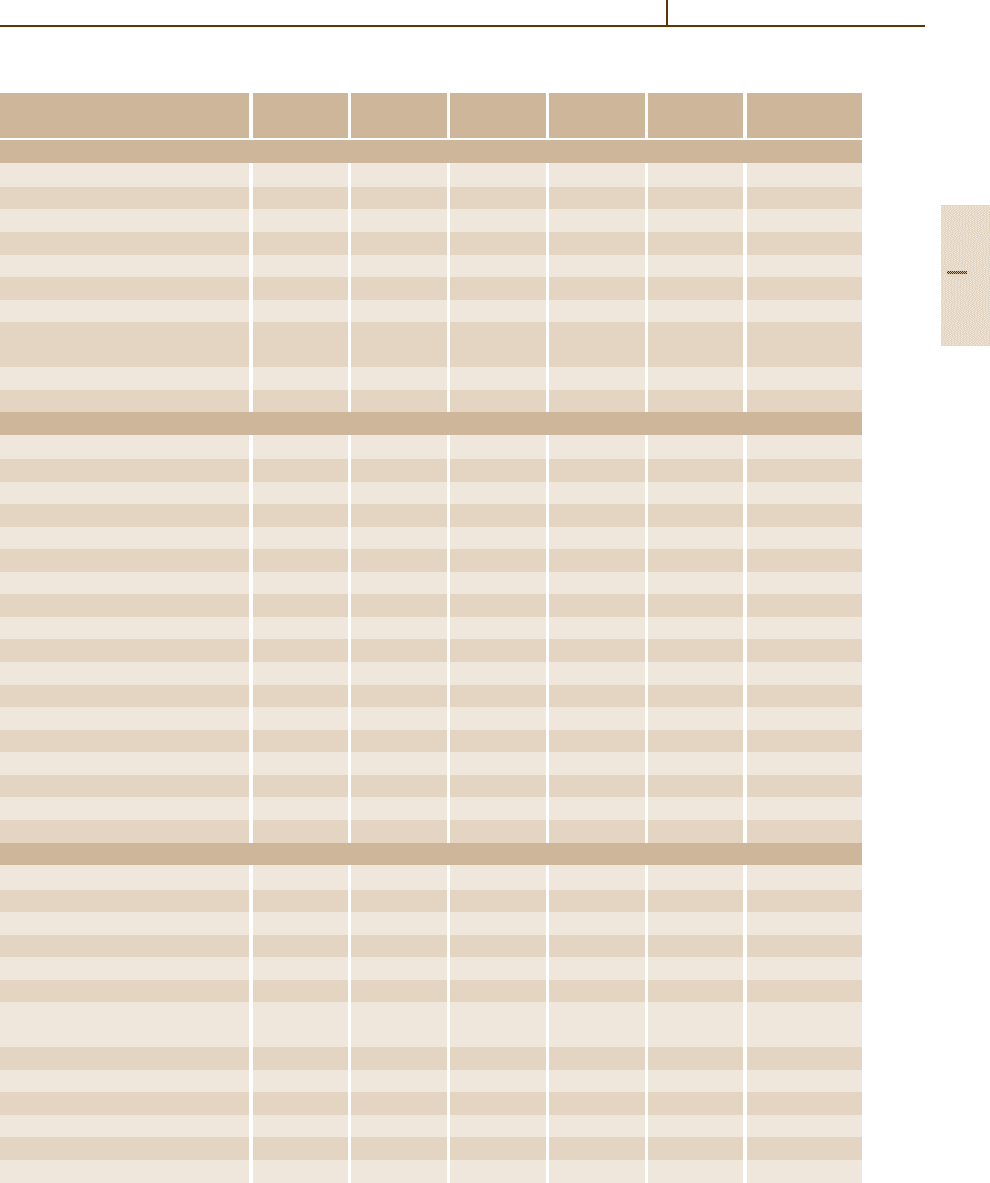
Superconductors 2.2 Non-Metallic Superconductors 713
Table 4.2-13 Electrical data of high-T
c
cuprates
Compound T
c
T
c
ρ(0);ρ(T
c
) H
c2
(0) λ
ab
(0) Ref.
(K) (K) (µ cm) (T) (nm)
A
2
CuO
4
family
Sr
2
CuO
4
25 [2.13]
La
1.9
Sr
0.1
CuO
4
33 6.5 320±16 [2.15]
La
1.875
Sr
0.125
CuO
4
36 4.5 270±13.5 [2.15]
La
1.85
Sr
0.15
CuO
4
39 2 0;33±6 45±10 218.5±10 [2.15]
La
1.775
Sr
0.225
CuO
4
29 7.5 [2.15]
La
1.725
Sr
0.275
CuO
4
22 10 [2.15]
Eu
2−x
Ce
x
CuO
4
23 [2.13]
(Nd
2−x
Ce
x
)CuO
4
24 2 250; 250 [2.13,16]
30
Pr
2−x
Ce
x
CuO
4
24 [2.13]
Sm
2−x
Ce
x
CuO
4
22 [2.13]
ABa
2
Cu
3
O
7
family
YBa
2
Cu
3
O
6.67
60 1 x;63±8 87 255 ±12.5 [2.15]
YBa
2
Cu
3
O
7
92 1 0;40±5 140±30 141.5 ±1 [2.15]
(Y
0.95
Pr
0.05
)Ba
2
Cu
3
O
7
90 1.8 50; 100 150±7.5 [2.15]
(Y
0.9
Pr
0.1
)Ba
2
Cu
3
O
7
86 2.2 50; 100 173±8.5 [2.15]
(Y
0.8
Pr
0.2
)Ba
2
Cu
3
O
7
78 3.2 100; 140 198 ±10 [2.15]
(Y
0.7
Pr
0.3
)Ba
2
Cu
3
O
7
60 7.5 250; 280 215 ±10 [2.15]
(Y
0.6
Pr
0.4
)Ba
2
Cu
3
O
7
40 13.2 300; 335 290 ±15 [2.15]
YBa
2
(Cu
0.99
Fe
0.01
)
3
O
7
91 1.3 [2.15]
YBa
2
(Cu
0.975
Fe
0.025
)
3
O
7
85 3 [2.15]
YBa
2
(Cu
0.95
Fe
0.05
)
3
O
7
75 5 [2.15]
YBa
2
(Cu
0.99
Zn
0.01
)
3
O
7
78 1 [2.15]
YBa
2
(Cu
0.975
Zn
0.025
)
3
O
7
62 1 150; 200 [2.15]
YBa
2
(Cu
0.95
Zn
0.05
)
3
O
7
36 1.5 240; 300 [2.15]
HoBa
2
Cu
3
O
7
92 1 [2.15]
NdBa
2
Cu
3
O
7
96 [2.13]
GdBa
2
Cu
3
O
7
94 [2.13]
ErBa
2
Cu
3
O
7
92 [2.13]
YbBa
2
Cu
3
O
7
89 [2.13]
A
m
E
2
Ca
n−1
Cu
n
O
2n+m+2
family
Bi
2
Sr
2
CaCu
2
O
7
107 [2.13]
Bi
2
Sr
2
CuO
6
34 [2.13]
Bi
2
(Sr
1.6
La
0.4
)CuO
6+x
23.5 320; 360 [2.15]
(Bi, Pb)
2
(Sr
1.75
La
0.25
)CuO
6
24 [2.15]
Bi
2
Sr
2
CaCu
2
O
8
(no anneal) 90 1 0;38 ±2 107 250 ±50 [2.15]
Bi
2
Sr
2
CaCu
2
O
8+x
(O
2
-annealed) 75 1 [2.15]
Bi
2
Sr
2
Ca
2
Cu
3
O
10
107 10 0; <60 [2.13, 15]
110
(Bi
1.6
Pb
0.4
)Sr
2
Ca
2
Cu
3
O
10
110 1 0; x 184 253 ±30 [2.15]
Bi
2
Sr
2
Ca
3
Cu
4
O
12
110 [2.13]
PbSr
2
CaCu
2
O
7
70 [2.13]
Pb
2
Sr
2
Ca
0.5
Ln
0.5
Cu
3
O
8
70 [2.16]
PbSr
2
Ca
2
Cu
3
O
9
122 [2.13]
AuBa
2
CaCu
2
O
7
82 [2.13]
Part 4 2.2
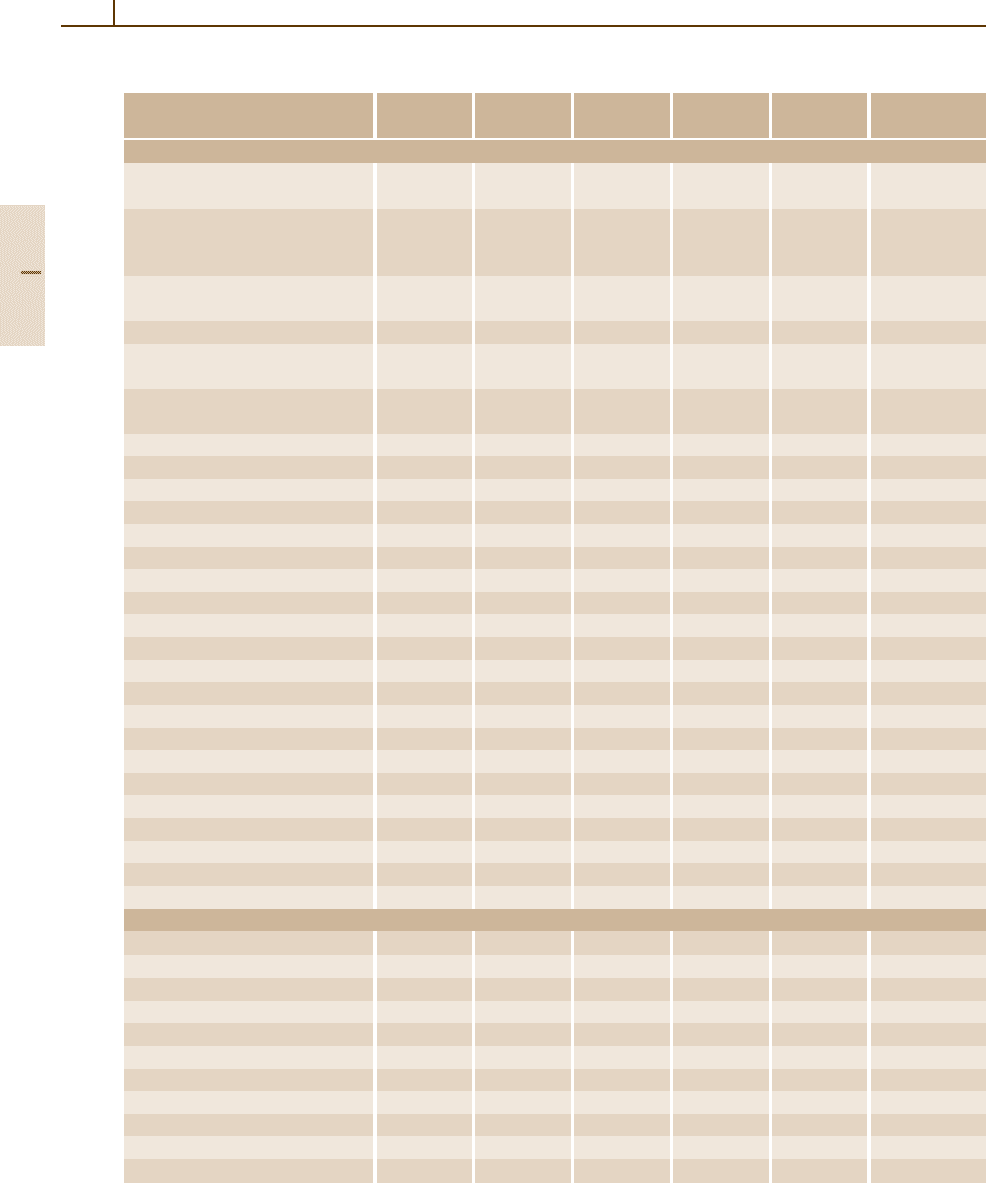
714 Part 4 Functional Materials
Table 4.2-13 Electrical data of high-T
c
cuprates, cont.
Compound T
c
T
c
ρ(0);ρ(T
c
) H
c2
(0) λ
ab
(0) Ref.
(K) (K) (µ cm) (T) (nm)
A
m
E
2
Ca
n−1
Cu
n
O
2n+m+2
family
Tl
2
Ba
2
CuO
6
85 40; 100 170±10 [2.13, 15]
90
Tl
2
Ba
2
CaCu
2
O
8
99 0 ±20; 99 221±10 [2.13,15,16]
110 300 ±80
119
Tl
2
Ba
2
Ca
2
Cu
3
O
10
125 20;83 75 196±10 [2.13,15]
128
Tl
2
Ba
2
Ca
3
Cu
4
O
12
119 [2.13]
TlBa
2
CaCu
2
O
7
82 [2.13,16]
103
TlBa
2
Ca
2
Cu
3
O
9
135 [2.13,16]
110
TlBa
2
Ca
3
Cu
4
O
11
127 [2.13]
(Tl
0.5
Pb
0.5
)Sr
2
CaCu
2
O
7
80 182±9 [2.15]
(Tl
0.5
Pb
0.5
)Sr
2
(Ca
0.8
Y
0.2
)Cu
2
O
7
107 0;250 [2.15]
(Tl
0.5
Pb
0.5
)Sr
2
Ca
2
Cu
3
O
9
122 158±8 [2.15]
TlSr
2
Ca
0.5
Y
0.5
Cu
2
O
7
90 [2.16]
CuBa
2
Ca
2
Cu
3
O
9
60 [2.13]
CuBa
2
Ca
3
Cu
4
O
11
117 [2.13]
Cu
2
Ba
2
Ca
2
Cu
3
O
10
67 [2.13]
Cu
2
Ba
2
Ca
3
Cu
4
O
12
113 [2.13]
BSr
2
Ca
2
Cu
3
O
9
75 [2.13]
BSr
2
Ca
3
Cu
4
O
11
110 [2.13]
BSr
2
Ca
4
Cu
5
O
13
85 [2.13]
Pb
2
(Y
1−x
Ca
x
)Sr
2
Cu
3
O
8
80 50;250 [2.15]
HgBa
2
CaCu
2
O
7
128 [2.13]
HgBa
2
Ca
2
Cu
3
O
9
135 [2.13]
HgBa
2
Ca
3
Cu
4
O
11
127 [2.13]
HgBa
2
Ca
4
Cu
5
O
13
110 [2.13]
HgBa
2
Ca
5
Cu
6
O
15
107 [2.13]
Hg
2
Ba
2
CaCu
2
O
7
44 [2.13]
Hg
2
Ba
2
Ca
2
Cu
3
O
9
45 [2.13]
Hg
2
Ba
2
Ca
3
Cu
4
O
12
114 [2.13]
AE
2
CuO
4−5
family
HgBa
2
CuO
5
97 [2.13]
TlBa
2
CuO
5
50 [2.13]
(Hg
0.8
V
0.2
)Ba
2
CuO
4.3
89 [2.14]
(Hg
0.8
Mo
0.2
)Ba
2
CuO
4.4
66 [2.14]
(Hg
0.9
Mo
0.1
)Ba
2
CuO
4.2
68 [2.14]
(Hg
0.8
W
0.2
)Ba
2
CuO
4.4
37 [2.14]
(Hg
0.9
W
0.1
)Ba
2
CuO
4.2
83 [2.14]
(Hg
0.8
Ru
0.2
)Ba
2
CuO
4.2
91 [2.14]
(Hg
0.7
Cr
0.3
)Sr
2
CuO
4.15
60 [2.14]
(Hg
0.8
Mn
0.2
)Ba
2
CuO
4.2
90 [2.14]
(Hg
0.8
Nb
0.2
)Ba
2
CuO
4.3
78 [2.14]
Part 4 2.2
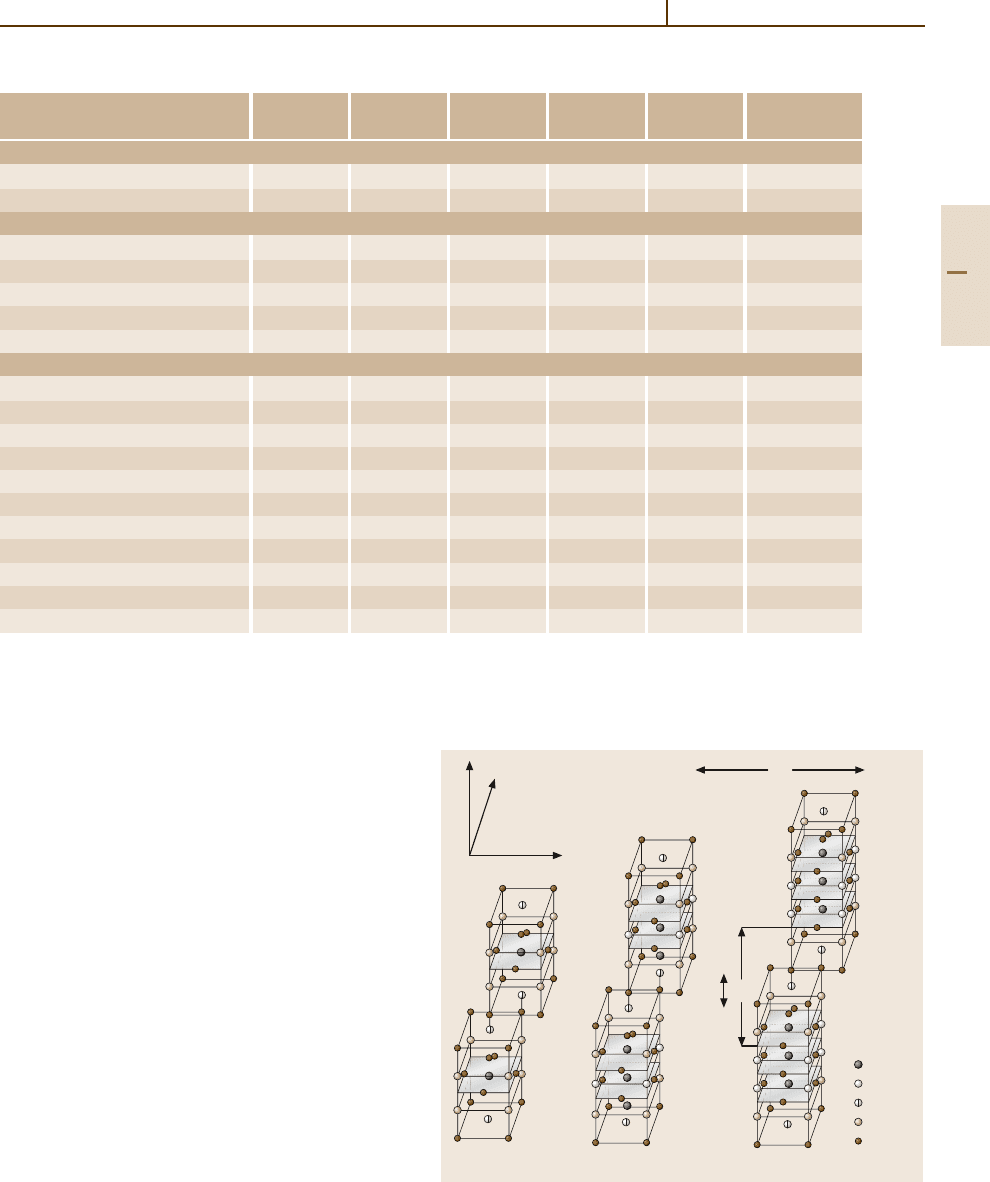
Superconductors 2.2 Non-Metallic Superconductors 715
Table 4.2-13 Electrical data of high-T
c
cuprates, cont.
Compound T
c
T
c
ρ(0);ρ(T
c
) H
c2
(0) Λ
ab
(0) Ref.
(K) (K) (µ cm) (T) (nm)
AE
2
CuO
4−5
family
(Hg
0.8
Mo
0.2
)Sr
2
CuO
x
78 [2.14]
(Hg
0.9
Re
0.1
)Sr
2
CuO
x
70 [2.14]
A
2
Ca
n−1
Cu
n
O
2n+2
family
Ba
2
CaCu
2
O
6
90 [2.13]
Ba
2
Ca
2
Cu
3
O
8
120 [2.13]
Ba
2
Ca
3
Cu
4
O
10
105 [2.13]
Ba
2
Ca
4
Cu
5
O
12
90 [2.13]
La
1.6
Sr
0.4
CaCu
2
O
6
60 10
Other compounds
YBa
2
Cu
4
O
8
80 2 196 ±10 [2.15]
HoBa
2
Cu
4
O
8
80 5 100; 400 161±8 [2.15]
Bi
2
Sr
2
(Ln
1−x
Ce
x
)
2
Cu
2
O
10
25 [2.16]
Ca
1–x
Sr
x
Cu
2
O
2
110 [2.16]
(Pb, Cu)Sr
2
(Ln, Ca)Cu
2
O
7
50 [2.16]
(Pb, Cu)(Sr, Eu)(Eu, Ce)Cu
2
O
x
25 [2.16]
Sr
1−x
Nd
x
CuO
2
40 [2.16]
Tl(Ba, La)CuO
5
40 [2.16]
Tl(Sr, La)CuO
5
40 [2.16]
(Tl
0.5
Pb
0.5
)Sr
2
CuO
6
40 [2.16]
(Tl
0.7
Cd
0.3
)BaLaCuO
5
48 [2.15]
spectively, are sandwiched between insulating blocks
consisting of m monolayers of A-oxide (m = 2and
A = Bi in Fig. 4.2-16) and two monolayers of E-oxide
(E =Sr in Fig. 4.2-16). These blocks can act as elec-
tronically active charge-reservoirs for hole or electron
donation to the copper-oxygen layers.
Superconducting Properties. By means of flux quan-
tization and Josephson tunneling experiments, it has
been firmly established that superconductivity in the
cuprate compounds is based on electron pairs similar to
that of conventional Bardeen–Cooper–Schreiffer (BCS)
superconductors. However, there are currently widely
Fig. 4.2-16 Schematic crystal structures of the ho-
mologous series of Bi
2
Sr
2
Ca
n−1
Cu
n
O
2n+4
supercon-
ductors with n = 1(Bi
2
Sr
2
CuO
6
, abbreviated as
Bi2201), n = 2(Bi
2
Sr
2
CaCu
2
O
8
−Bi2212) and n =
3(Bi
2
Sr
2
Ca
2
Cu
3
O
10
−Bi2223). The coherence length in
the c-direction, ξ
c
, is compared to that perpendicular to
the c-direction, ξ
ab
, and to the distance d between the
superconducting CuO
2
/Ca stacks
differing views as to the pairing mechanism and no con-
sensus exists on a proper microscopic theory. In addition
ξ
ab
BiO
SrO
CuO
2
Ca
BiO
SrO
CuO
2
Ca
CuO
2
Cu
Ca
Bi
Sr
O
c
b
a
d
Bi2201 Bi2212 Bi2223
ξ
c
Part 4 2.2
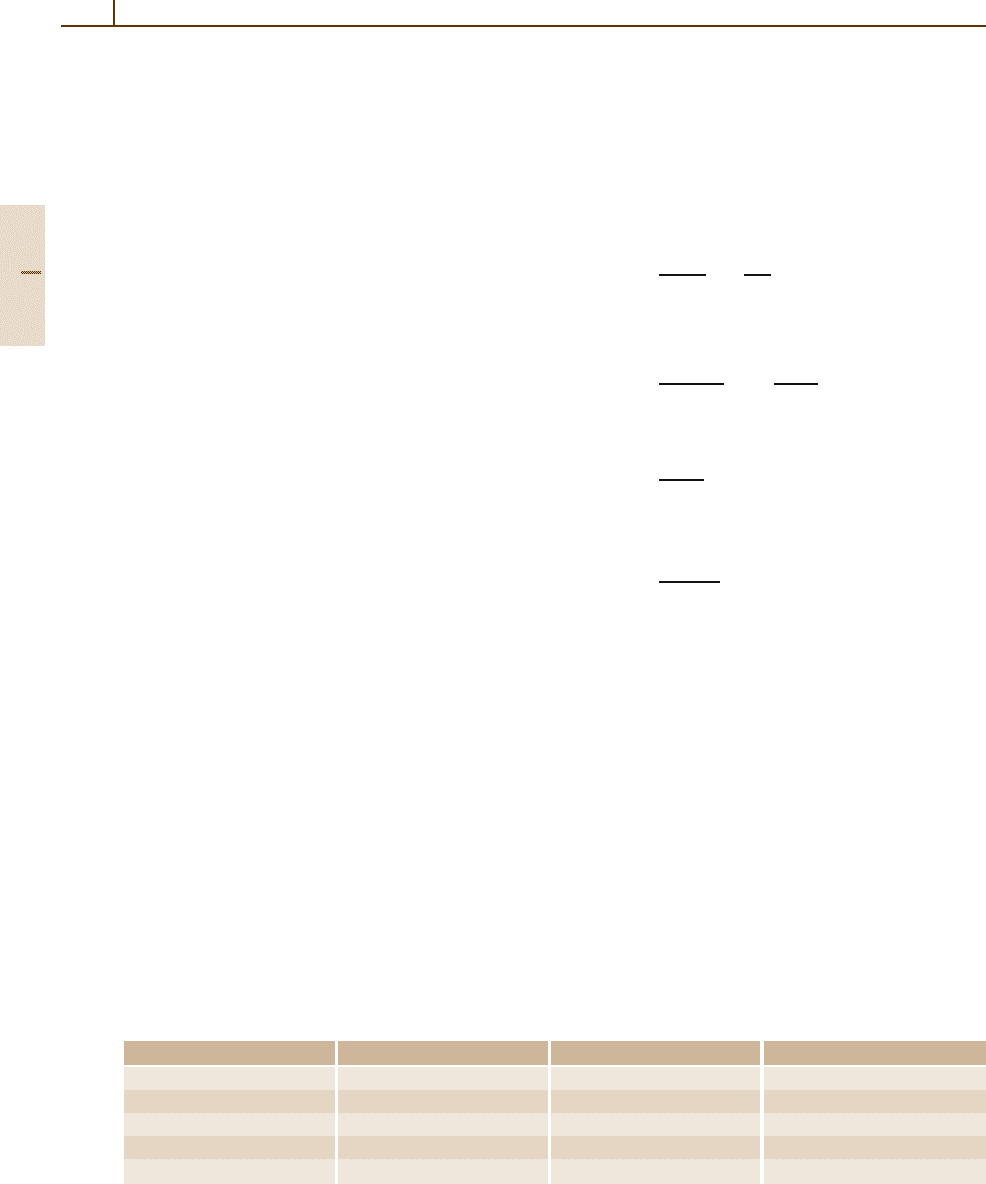
716 Part 4 Functional Materials
to the conventional electron–phonon interaction other
explanations have been proposed [2.17].
Compared to the conventional superconductors, the
superconducting cuprate compounds exhibit signifi-
cantly higher values of T
c
, much smaller coherence
lengths ξ, and a high anisotropy of the electronic
transport properties. The anisotropy is caused by the
layered structure of the cuprates (Fig. 4.2-16) and by
the fact, concluded from both experiments and theoreti-
cal considerations, that superconductivity is essentially
confined to the CuO
2
-planes. The superconductive cou-
pling between the CuO
2
layers within a CuO
2
/E stack
and within a CuO
2
/L stack, respectively, is much
weaker than the coupling within the CuO
2
layers.
This is demonstrated qualitatively in Fig. 4.2-16 by
the coherence lengths ξ
ab
and ξ
c
within the CuO
2
plane and in the c-direction, respectively, for the com-
pound Bi
2
Sr
2
Ca
2
Cu
3
O
10
, ξ
c
is of the order of the
distance between two CuO
2
layers within the CuO
2
/Ca
stack. The coupling between neighboring CuO
2
/Ca
stacks separated by the BiO- and SrO-layers is even
weaker. This coupling can be described as Josephson
type. For the two compounds YBa
2
Cu
3
O
7−δ
and Pb
doped Bi
2
Sr
2
Ca
2
Cu
3
O
10−x
, which are the most promis-
ing high-T
c
conductors for technical applications, the
anisotropy of the superconducting properties caused by
the quasi 2-dimensional nature of superconductivity in
high-T
c
conductors is demonstrated and compared to
the typical low temperature superconductor Nb
3
Sn in
Table 4.2-14; γ is the anisotropic parameters defined
as γ = ξ
ab
/ξ
c
≡ λ
c
/λ
ab
. The identity is derived from
the anisotropic Ginzburg–Landau equations. Here λ
ab
and λ
c
are the London penetration depths for a mag-
netic field in the c-direction and parallel to the ab-plane,
respectively. Considerably different values have been
published for the parameters of the high-T
c
compounds
given in Table 4.2-14. For more details and references
see Sects. 4.2.2.2 and 4.2.2.3.
All high-T
c
cuprate compounds are Type II su-
perconductors. While a microscopic theory which can
describe the high-T
c
superconductivity sufficiently is
Table 4.2-14 Critical temperature T
c
, anisotropy coefficients and coherence lengths of three superconducting compounds
Nb
3
Sn YBa
2
Cu
3
O
7−δ
Bi
2
Sr
2
Ca
2
Cu
3
O
10−x
T
c
(K) 18 92 110
γ 1 ≈ 5 ≈ 50
ξ 3(0K)
ξ
ab
(nm) 2.5 (0 K) 2(0K)
ξ
c
(nm) 0.5 (0 K) 0.05 (0 K)
missing, an understanding of this field is reached on
the basic assumption that the phenomenological theo-
ries [2.18] of London and of Ginsburg and Landau also
hold for high-T
c
superconductors. Following these the-
ories, the critical fields can be expressed through the
corresponding values of the coherence length ξ and the
London penetration depth λ. The lower critical field is
given by
H
c1||
=
Φ
0
4πλ
2
ab
ln
λ
ab
ξ
ab
+0.5
and
H
c1
⊥
=
Φ
0
4πλ
ab
λ
c
ln
λ
ab
λ
c
ξ
ab
ξ
c
1/2
+0.5
,
and the relations for the upper critical fields are
H
c2||
=
Φ
0
2πξ
2
ab
and
H
c2
⊥
=
Φ
0
2πξ
ab
ξ
c
.
H
c|
and H
c
⊥
are the critical fields along the c axis and
along the ab-plane, respectively; Φ
0
= hc/2e is the flux
quantum.
Magnetic fields ≥ H
c1
penetrate into bulk super-
conductors in the form of vortices. The structure of
the vortices in layered superconducting cuprates is
quite different from that in low-T
ic
conductors. Within
conventional low-T
ic
superconductors the vortices are
always line-like Abrikosov vortices (vortex lines). Each
of them carries one flux quantum. In principle, it is
a tube with the radius of the London penetration depth λ
in which superconducting screening currents circulate
around a small non-superconducting core of the radius of
the coherence length ξ. But the structure of the vortices
in high-T
c
superconductors depends on the anisotropy
of the compounds and the angle of the applied field
Part 4 2.2
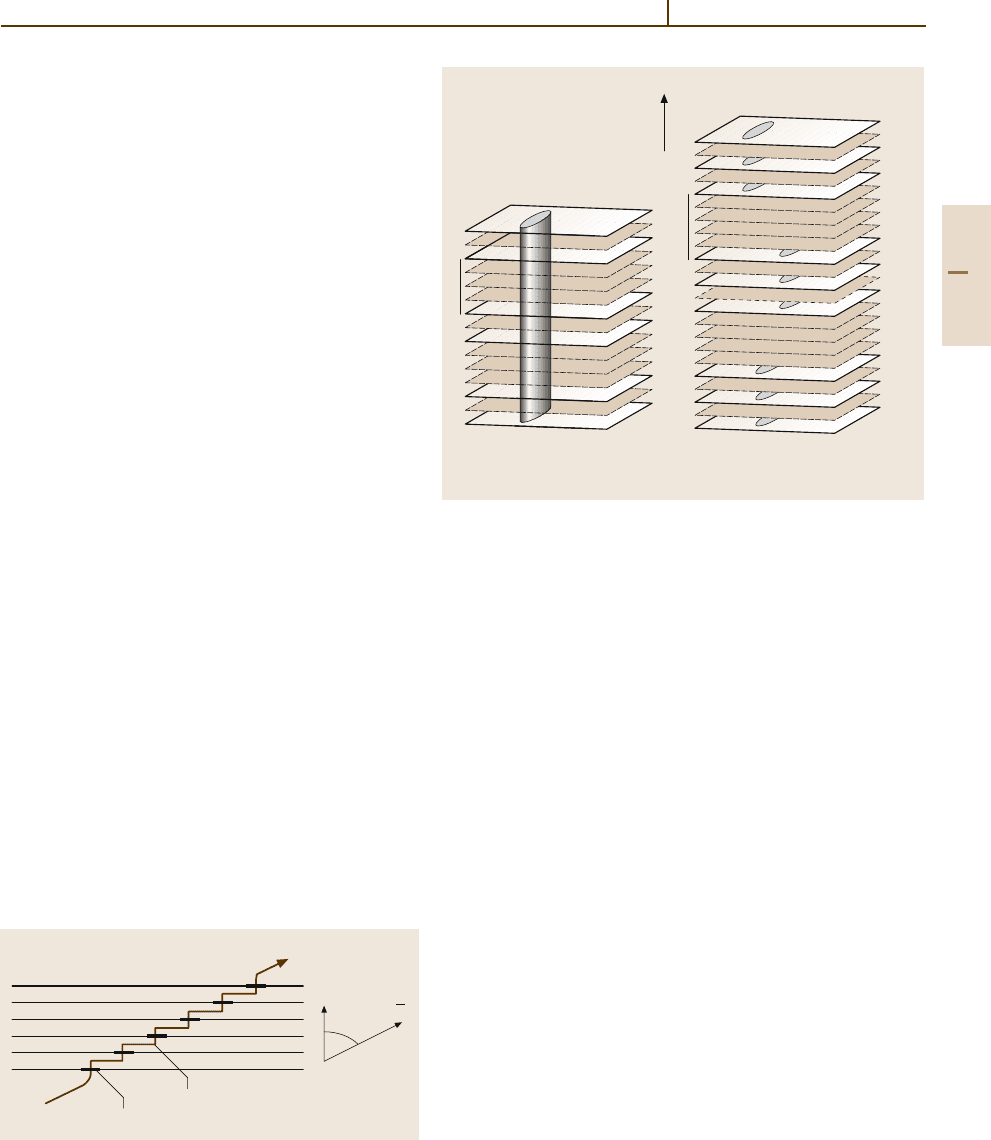
Superconductors 2.2 Non-Metallic Superconductors 717
with regard to the crystal planes. In a field parallel to
the c-direction in cuprates of low anisotropy such as
YBa
2
Cu
3
O
7−δ
the structure of the vortices is similar to
that of conventional superconductors. However, in com-
pounds of large anisotropy, in which the distance, d,
between the Cu
2
-stacks is larger than two times the
coherence length, ξ
c
, the vortex lines tend to disinte-
grate into stacks of vortices in different layers that are
shaped like pancakes, due to the low Cooper pair density
(Fig. 4.2-17).
Only a weak attractive interaction occurs between
the pancake vortices of different layers, the strength
of which depends on the magnetic field and the tem-
perature. Therefore the pancake vortices are much more
flexible than the continuous, relatively rigid vortex lines
in conventional superconductors.
An external field parallel to the superconducting
ab-planes penetrates into the sample in the form of so-
called Josephson vortices. They differ from Abrikosov
ones by the absence of a vortex core. The super-
conducting shielding currents are strongly confined to
the ab-planes. In fields occurring at a small angle
to the ab-plane the vortices have a step-like charac-
ter (Fig. 4.2-18). They consist of a periodic sequence
of parts parallel (Josephson vortices) and perpendicu-
lar (Abrikosov vortices) to the ab-planes, respectively.
The distance between the “Abrikosov-parts” depends
on Θ.
For large-scale applications of the superconducting
cuprate phases, an effective pinning of the vortices is
an indispensable precondition. Pinning centers can be
small defects of the crystal structure such as oxygen va-
cancies, dislocation loops, screw dislocations (e.g., in
thin films), stacking faults, precipitates, and substitu-
tional atoms of foreign elements in the superconducting
compound. In a magnetic field parallel to the ab-planes,
an intrinsic pinning is effective due to the interaction of
c
B
Θ
Josephson vortex
Pancake vortex
Fig. 4.2-18 Vortex line caused by an external field exhibit-
ing an angle Θ to the ab-planes
d ~2ξ
d
d
CuO
2
CuO
2
CuO
2
BaO
Y
BaO
CuO
BaO
BiO
SrO
CuO
2
Ca
BiO
SrO
CuO
2
Ca
CuO
2
Bi
2
Sr
2
Ca
2
Cu
3
O
10
YBa
2
Cu
3
O
7
B
3D-vortex line 2D-pancake vortices
d >2ξ
Fig. 4.2-17 Vortex line in YBa
2
Cu
3
O
7
(left-hand picture)and
pancake vortices in Bi
2
Sr
2
Ca
2
Cu
3
O
10
(right-hand picture); the Cu
2
-
planes are drawn with bold lines and the isolating planes with broken
lines
the Josephson vortices with the periodic potential orig-
inating from the CuO
2
planes. This kind of pinning is
much stronger than that caused by crystal defects.
In contrast to conventional superconductors, ther-
mal fluctuations of the vortex positions become very
important in high-T
c
materials, in particular close to
H
c2
(T ). This is a consequence of both the small coher-
ence length ξ
c
and the fact that the pinning centers in the
cuprates are mainly provided by point defects.
In view of the thermal fluctuation and pinning, the
behavior of the vortices determining the resistivity of the
system can be demonstrated by the H–T phase diagram
proposed by [2.19]. A schematic representation is given
in Fig. 4.2-19.
An important new feature compared to conventional
superconductors is the existence of new vortex phases:
a vortex glass phase and a vortex liquid. In cuprates with-
out vortex pinning, a vortex lattice exists in place of the
vortex glass. The presence of pinning centers leads to
the destruction of the translational long-range order of
the vortices, forming the vortex glass phase in which the
resistivity is exponentially small. A truly superconduct-
ing state with essentially zero resistivity, ρ(J → 0) → 0
(J = current density) exists only for this phase. Upon
increasing the temperature and magnetic field, respec-
Part 4 2.2
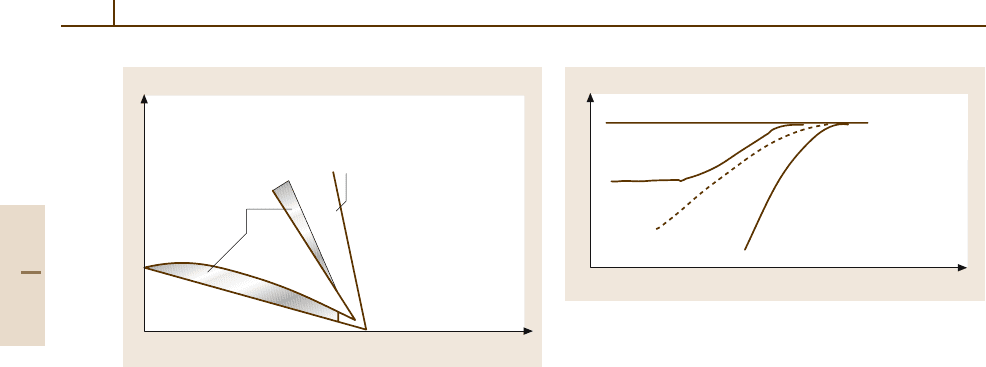
718 Part 4 Functional Materials
Vortex glass
Pinned vortex
liquid
Unpinned vortex
liquid
H
c1
(T)
H
c2
(T)
B
m1
(T)
B
m2
(T)
T
c
T
H
Fig. 4.2-19 Schematic phenomenological phase diagram
for the high-T
c
superconductors, including the effects of
thermal fluctuations and pinning
tively, crossing the “melting line” B
m1
(T ), the coupling
between the vortices vanishes completely (i. e., the shear
modulus c
66
of the vortex system becomes zero) and the
vortex glass “melts”, forming the vortex liquid. Close to
B
m1
(T ) the vortex liquid is in the pinned regime because
the activation energy U of the vortex motion is still large
compared to the thermal energy k
B
T(k
B
= Boltzmann
constant). However, in this field-temperature region the
resistivity is not zero and its temperature dependence
P = E
0
/J
0
c
U/k
B
T exp[−U/k
B
T ] for small J follows
an Arrhenius law, i. e., the system is in a thermally acti-
vated flux flow (TAFF) regime where E
0
is the electrical
field in the absence of energy barriers and J
0
c
the critical
current density at T = 0 K [2.20]. When U is consider-
able larger then k
B
T (U/k
B
T ≥ 10) a measurable “flux
creep” is observed. Closer to the upper critical field
H
c2
(T ) the activation energy U is small, U < k
B
T ,and
the vortex liquid cannot be pinned. The system is in the
flux flow (FF) regime. With increasing temperature in
this H–T region ρ varies smoothly to the resistivity of
the normal state.
The existence of a characteristic irreversibility line
B
irr
(T ), which is the boundary between the reversible
and irreversible magnetization of the superconductor, is
closely related to the vortex glass/vortex liquid transi-
tion. By crossing this line from lower to higher B values,
the critical current density goes to zero. It should be
noted that the vortex glass melts not only on cross-
ing B
m1
(T ) but also with decreasing magnetic field
near H
c1
(T ) crossing the line B
m2
(T ),asshownin
Fig. 4.2-19. As the field decreases, the distance between
the vortices increases and eventually exceeds the Lon-
don penetration depth λ. In this case, the vortex–vortex
Vortex glassT > T
m
T
m
T < T
m
log j
log ρ
FF
TAFF
Fig. 4.2-20 Schematic representation of the resistivity ρ
and its dependence on the current density j for three differ-
ent regions in the phenomenological phase diagram (T
m
is
the melting line) [2.19]
interaction is exponentially small, and consequently the
shear modulus c
66
decays rapidly, leading to a “melting”
of the vortex glass.
For each vortex state a specific resistivity–current
relation exists, as schematically shown in Fig. 4.2-20.
A linear relation occurs for the “flux flow” regime only.
Therefore a voltage criterion for the critical current has
to be defined. The one generally used is 1µVcm
−1
.Ex-
tensive reviews of the structure and behavior of vortices
in high-T
c
superconductors are given in [2.19,20].
A significant limitation to the critical current den-
sity J
c
of high-T
c
materials is given by the grain
boundaries which act as strong resistive barriers to
current flow. Figure 4.2-21 shows that the critical
current density J
c
of YBa
2
Cu
3
O
7−x
exhibits an ex-
ponential dependence on the misorientation angle θ
between the neighboring crystallites [2.21]. Similar an-
gular dependencies of the grain boundary critical current
density were observedfor all other high-T
c
superconduc-
tors [2.21].
This weak link (current obstruction) behavior re-
sults from the fact that the width of the disturbed crystal
lattice region at the grain boundary is on the order
of the coherence length. Therefore, for higher angles,
a grain boundary becomes a Josephson weak link due
to the local suppression of the superconducting order
parameter. The reasons which may be responsible for
the suppression of the order parameter leading to the
strong dependence of J
c
on θ are discussed extensively
in [2.21].
Applications. The advantage of high-T
c
superconduc-
tors is that superconductivity is achieved at temperatures
above 77 K where liquid nitrogen can be used as
a coolant. However, for many potential applications,
Part 4 2.2

Superconductors 2.2 Non-Metallic Superconductors 719
J
C
(A/mm
–2
)
10
8
10
6
10
4
10
2
01020304050
Grain boundary angle (deg)
Fig. 4.2-21 Critical current densities of [001] tilt grain
boundaries in YBa
2
Cu
3
O
7−x
films as a function of tilt an-
gle. The data published by different authors were compiled
by [2.21]
round or flat wires (tapes) with a high critical current
density in strongmagnetic fields are required. This is true
in particular for the use of high-T
c
materials in electric
power utility devices. Some performance requirements
for various electric power applications are summarized
in Table 4.2-15 [2.22].
Two main problems discussed above have to be
overcome in order to achieve high J
c
values. The first
one is the current barrier behavior of the grain bound-
aries, which can be solved by texturing of the crystalline
Table 4.2-15 Requirements for industrial wire performance in various utility device applications
Application J
c
Prevailing Temperature J
c
Wire Strain Band
field strength length radius
(A/cm
2
) (T) (K) (A) (m) (%) (m)
Fault current 10
4
–10
5
0.1–3 20–77 10
3
–10
4
1000 0.2 0.1
limiter
Large motor 10
5
4–5 20–77 500 1000 0.2–0.3 0.05
Generator 10
5
4–5 20–50 >1000 1000 0.2 0.1
SMES
a
10
5
5–10 20–77 ≈ 10
4
1000 0.2 1
Transmission 10
4
–10
5
<0.2 65–77 100 per 100 0.4 2 (cable)
cable
strand
Transformer 10
5
0.1–0.5 65–77 10
2
–10
3
1000 0.2 1
a
SMES: superconducting magnetic-energy storage
0 306090120
40
30
20
10
0
Temperature (K)
Field strength (T)
Helium Neon Nitrogen
Hydrogen
Nb
3
Sn
Bi-2223
YBCO
MgB
2
bulk
Nb-TiNb-Ti
Nb-Ti
Fig. 4.2-22 Magnetic field strength versus temperature di-
agram for various superconducting materials. The upper
critical field H
c2
is indicated by thin lines, while the irre-
versibility field thick lines indicate H
irr
microstructure of the superconducting phase. The sec-
ond one is the flux flow and flux creep particularly in
highly anisotropic materials which have to be avoided
and minimized, respectively, in order to obtain a low-
loss conductor. Considerable efforts are directed towards
flux pinning by the creation of effective pinning centers
for the improvement of J
c
in high fields at 77 K.
A measurable parameter characterizing the pinning
behavior is H
irr
(T ) as mentioned above. In Fig. 4.2-22
this parameter is plotted for the two high-T
c
mater-
ials Yba
2
Cu
3
O
x
(YBCO) and (Bi, Pb)
2
Sr
2
Ca
2
Cu
3
O
x
(Bi-2223), which have the most promising H
irr
charac-
teristics for large scale applications in comparison with
H
irr
of conventional superconductors.
Part 4 2.2
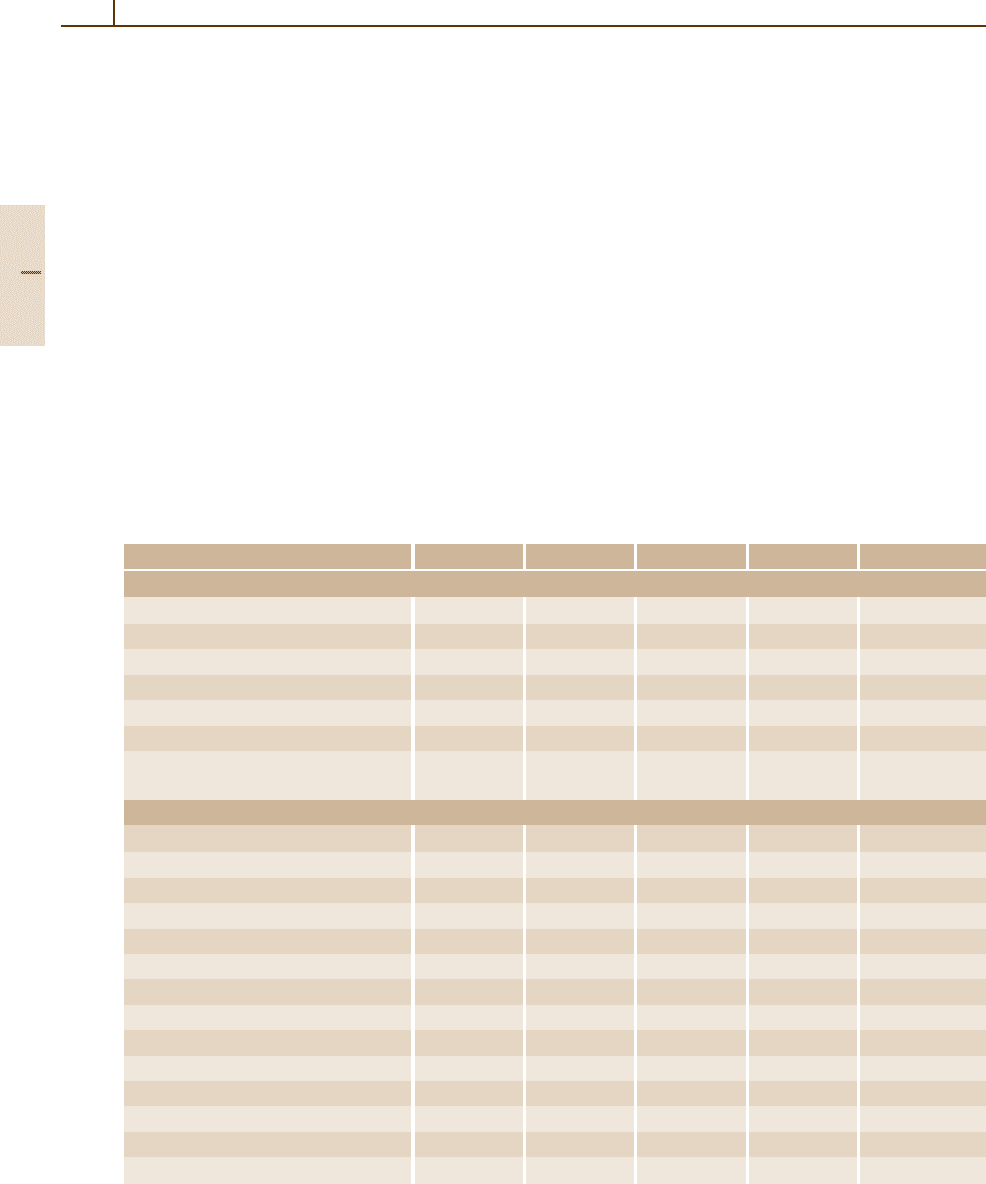
720 Part 4 Functional Materials
At present, the only high-T
c
conductor produced
in the form of long wires and tapes is Ag-sheathed
Bi-2223. However, a shortcoming of this conductor is
the fact, shown in Fig. 4.2-22, that it exhibits an enor-
mous suppression of H
irr
(T ) to the very low value of
0.2 T due to the large anisotropy. Although this does not
preclude the use of Bi-2223 for power cables, there is
not much scope for use at 77 K in any magnetic field
of significant magnitude. This shortcoming of Bi-2223
is an important driving force for the development of
a technology based on YBCO, for which H
irr
(77 K)
≈ 7T.
Specific properties of superconductors at 77 K may
be used for electronic applications, e.g., for passive
microwave devices such as transmission lines and high-
quality resonators. YBCO is widely used in active
devices such as SQUIDs and detectors based on Joseph-
son and quasi-particle tunnelling. A further field of
Table 4.2-16 Structural data of high-T
c
cuprates
Compound Space Group a (nm) b (nm) c (nm) Ref.
A
2
CuO
4
family
La
1.9
Sr
0.1
CuO
4
I4/mmm 0.37839 0.37839 1.3211 [2.15]
La
1.875
Sr
0.125
CuO
4
I4/mmm 0.37784 0.37784 1.3216 [2.15]
La
1.85
Sr
0.15
CuO
4
La
1.85
Sr
0.15
CuO
4
I4/mmm 0.37793 0.37793 1.32260 [2.15]
La
1.775
Sr
0.225
CuO
4
I4/mmm 0.37708 0.37708 1.3247 [2.15]
La
1.725
Sr
0.275
CuO
4
I4/mmm 0.37666 0.37666 1.3225 [2.15]
(Nd
2−x
Ce
x
)CuO
4
I4/mmm 0.39469 0.39469 1.20776 [2.15,16]
I4/mmm 0.395 1.207
LBa
2
Cu
3
O
7−x
family
YBa
2
Cu
3
O
6.67
Pmmm 0.3831 0.3889 1.1736 [2.15]
YBa
2
Cu
3
O
7
Pmmm 0.38198 0.38849 1.16762 [2.15]
(Y
0.95
Pr
0.05
)Ba
2
Cu
3
O
7
Pmmm [2.15]
(Y
0.9
Pr
0.1
)Ba
2
Cu
3
O
7
Pmmm [2.15]
(Y
0.8
Pr
0.2
)Ba
2
Cu
3
O
7
Pmmm [2.15]
(Y
0.7
Pr
0.3
)Ba
2
Cu
3
O
7
Pmmm [2.15]
(Y
0.6
Pr
0.4
)Ba
2
Cu
3
O
7
Pmmm [2.15]
YBa
2
(Cu
0.99
Fe
0.01
)
3
O
7
Pmmm [2.15]
YBa
2
(Cu
0.975
Fe
0,025
)
3
O
7
Pmmm [2.15]
YBa
2
(Cu
0.95
Fe
0.05
)
3
O
7
Pmmm [2.15]
YBa
2
(Cu
0.99
Zn
0.01
)
3
O
7
Pmmm [2.15]
YBa
2
(Cu
0.975
Zn
0.025
)
3
O
7
Pmmm 0.3820 0.3890 1.1673 [2.15]
YBa
2
(Cu
0.95
Zn
0.05
)
3
O
7
Pmmm 0.3820 0.38851 1.1671 [2.15]
HoBa
2
Cu
3
O
7
Pmmm 0.38460 0.3881 1.1640 [2.15]
application is the use for high-quality reliable and repro-
ducible high-T
c
Josephson junctions. A more extensive
account of real and potential large-scale applications,
respectively, is given in [2.23].
Electrical and Structural Data of High-T
c
Supercon-
ductors.
In Tables 4.2-13 and 4.2-16 electrical and
structural data, respectively, of selected high-T
c
cuprates
are summarized. The data were compiled on the ba-
sis of review articles [2.13–16]. In many cases the real
stoichiometric coefficients of oxygen are a few tenths
higher or lower than the one-digit numbers indicated
in the formulas of the tables. The value ∆T
c
is the
difference between the temperatures at which the re-
sistance reached 90% and 10% of the normal state
resistance, respectively, during cooling of the sample;
ρ(0) is the residual resistivity expressed by the formula
ρ(T > T
c
) = ρ(0) +β(T ) with β = dρ/ dT.
Part 4 2.2
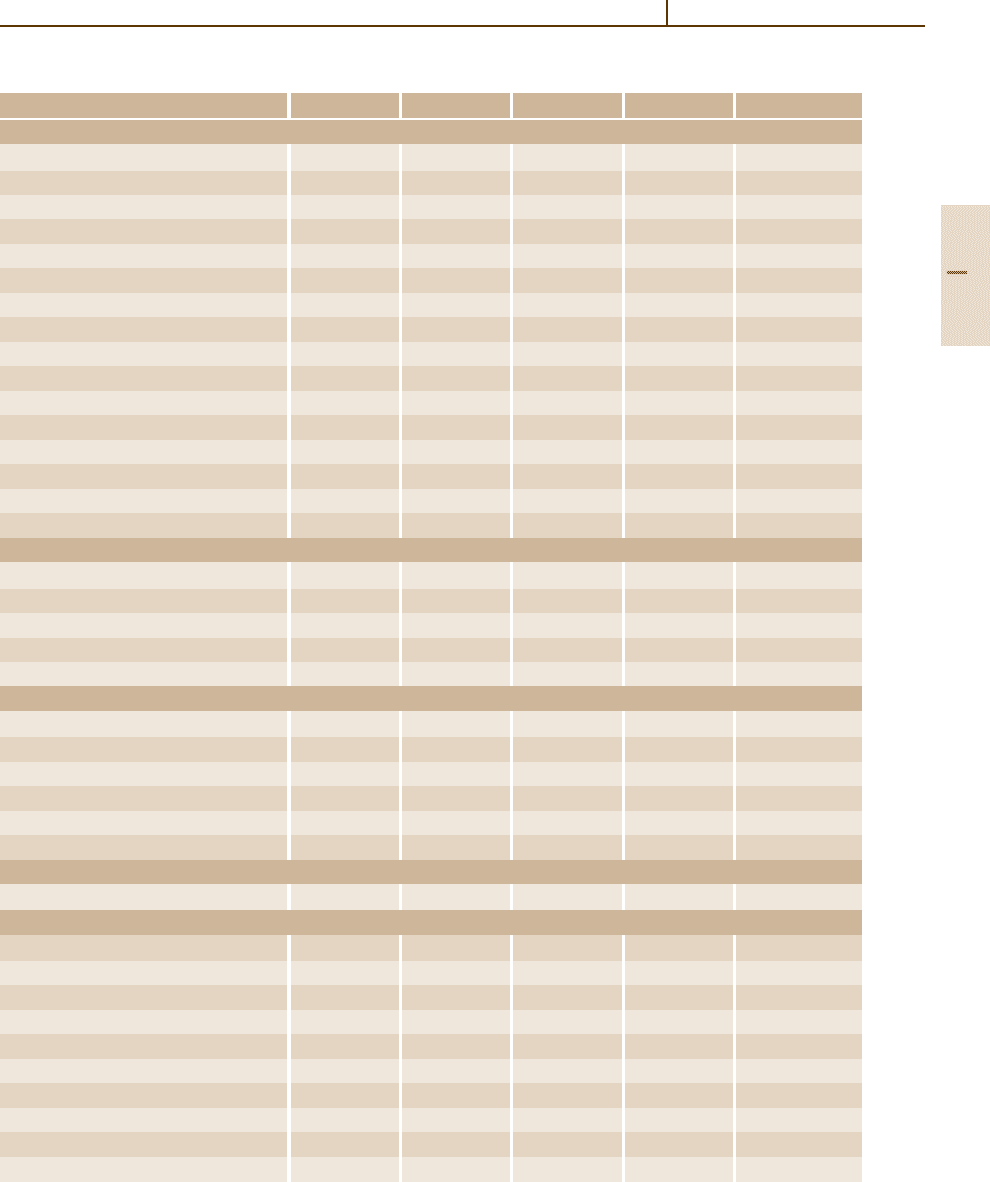
Superconductors 2.2 Non-Metallic Superconductors 721
Table 4.2-16 Structural data of high-T
c
cuprates, cont.
Compound Space Group a (nm) b (nm) c (nm) Ref.
A
m
E
2
Ca
n−1
Cu
n
O
2n+m+2
family
Bi
2
(Sr
1.6
La
0.4
)CuO
6+x
Cmmm 0.5370 0.5400 0.2450 [2.15]
(Bi, Pb)
2
(Sr
1.75
La
0.25
)CuO
6
Cmmm 0.5282 0.5410 2.462 [2.15]
Bi
2
Sr
2
CaCu
2
O
8
(no-anneal) Fmmm 0.5413 0.5411 3.091 [2.15]
Bi
2
Sr
2
CaCu
2
O
8+x
(O
2
-annealed) Fmmm 0.5408 0.5413 3.081 [2.15]
Bi
2
Sr
2
Ca
2
Cu
3
O
10
Fmmm 0.539 0.539 3.71 [2.15]
(Bi
1.6
Pb
0.4
)Sr
2
Ca
2
Cu
3
O
10
Fmmm 0.5413 0.5413 3.7100 [2.15]
Pb
2
Sr
2
Ca
0.5
Ln
0.5
Cu
3
O
8
C/mmm 0.5435 0.5463 1.5817 [2.16]
Tl
2
Ba
2
CuO
6
I4/mmm 0.3866 0.38662 2.3239 [2.15]
Tl
2
Ba
2
CaCu
2
O
8
I4/mmm 0.38550 0.38550 2.9318 [2.15,16]
Tl
2
Ba
2
Ca
2
Cu
3
O
10
I4/mmm 0.38503 0.38503 3.588 [2.15]
TlBa
2
Ca
2
Cu
3
O
9
P4/mmm 0.3853 1.5913 [2.16]
(Tl
0.5
Pb
0.5
)Sr
2
CaCu
2
O
7
P4/mmm 0.38023 0.38023 1.2107 [2.15]
(Tl
0.5
Pb
0.5
)Sr
2
(Ca
0.8
Y
0.2
)Cu
2
O
7
P4/mmm 0.38075 0.38075 1.2014 [2.15]
(Tl
0.5
Pb
0.5
)Sr
2
Ca
2
Cu
3
O
9
P4/mmm 0.38206 0.38206 1.5294 [2.15]
TlSr
2
Ca
0.5
Y
0.5
Cu
2
O
7
P4/mmm 0.380 1.210 [2.16]
Pb
2
(Y
1−x
Ca
x
)Sr
2
Cu
3
O
8
Cmmm 0.53933 0.54311 1.57334 [2.15]
AE
2
CuO
4−5
family
(Hg
0.8
V
0.2
)Ba
2
CuO
4.3
0.38860 0.9338 [2.14]
(Hg
0.8
Mo
0.2
)Ba
2
CuO
4.4
0.3882 0.9378 [2.14]
(Hg
0.9
Mo
0.1
)Ba
2
CuO
4.2
0.3875 0.9435 [2.14]
(Hg
0.8
W
0.2
)Ba
2
CuO
4.4
0.3871 0.9416 [2.14]
(Hg
0.9
W
0.1
)Ba
2
CuO
4.2
0.3875 0.9450 [2.14]
AE
2
CuO
4−5
family
(Hg
0.8
Ru
0.2
)Ba
2
CuO
4.2
0.3879 0.9473 [2.14]
(Hg
0.7
Cr
0.3
)Sr
2
CuO
4.15
0.3845 0.8683 [2.14]
(Hg
0.8
Mn
0.2
)Ba
2
CuO
4.2
0.3890 0.9343 [2.14]
(Hg
0.8
Nb
0.2
)Ba
2
CuO
4.3
0.3885 0.9461 [2.14]
(Hg
0.8
Mo
0.2
)Sr
2
CuO
x
0.3797 0.8818 [2.14]
(Hg
0.9
Re
0.1
)Sr
2
CuO
x
0.3783 0.8883 [2.14]
A
2
Ca
n−1
Cu
n
O
2n+2
family
La
1.6
Sr
0.4
CaCu
2
O
6
I4/mmm 0.38208 0.38208 1.95993 [2.15]
Other Compounds
YBa
2
Cu
4
O
8
Ammm 0.386 0.386 2.724 [2.15]
HoBa
2
Cu
4
O
8
Ammm 0.3855 0.3874 2.7295 [2.15]
Bi
2
Sr
2
(Ln
1−x
Ce
x
)
2
Cu
2
O
10
P4/mmm 0.3888 1.728 [2.16]
YBa
2
(Cu
0.99
Fe
0.01
)
3
O
7
Pmmm [2.15]
YBa
2
(Cu
0.975
Fe
0.025
)
3
O
7
Pmmm [2.15]
YBa
2
(Cu
0.95
Fe
0.05
)
3
O
7
Pmmm [2.15]
YBa
2
(Cu
0.99
Zn
0.01
)
3
O
7
Pmmm [2.15]
YBa
2
(Cu
0.975
Zn
0.025
)
3
O
7
Pmmm 0.3820 0.3890 1.1673 [2.15]
YBa
2
(Cu
0.95
Zn
0.05
)
3
O
7
Pmmm 0.3820 0.38851 1.1671 [2.15]
HoBa
2
Cu
3
O
7
Pmmm 0.38460 0.3881 1.1640 [2.15]
Part 4 2.2
